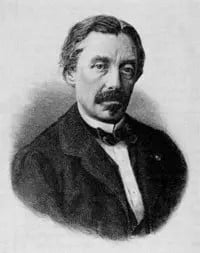February 3, 1851: Léon Foucault Demonstrates That Earth Rotates
By the mid 19th century, most educated people knew that Earth spins on its axis, completing a rotation once a day, but there was no obvious visual demonstration of the Earth’s rotation, only astronomical evidence.
As early as Galileo’s time, scientists had tried to demonstrate Earth’s rotation by dropping objects and measuring how far eastward they landed, but these efforts were too crude and inaccurate to be conclusive.

Not until Léon Foucault’s famous pendulum demonstration in 1851 was there clear dynamical proof of Earth’s rotation.
Jean Bernard Léon Foucault was born in Paris in September 1819, the son of a publisher. In his school days, he was a rather timid boy and never had much success academically. Much of his education was obtained at home. His mother wanted him to become a doctor, so he enrolled in medical school, but he quickly found he couldn’t stand the sight of blood and dropped out.
Foucault lacked formal scientific training, but he had great dexterity, a talent for building mechanical gadgets, and a great intuitive understanding of nature. After leaving medical school, Foucault worked as a lab assistant. He then took an interest in the recently invented Daguerre photographic process and used it to produce the first photograph of the sun. With his collaborator Armand Fizeau, he devised a way to measure the speed of light using rotating mirrors, and in 1850, he showed that light travels more slowly in water than in air.
One night in early January 1851, at about 2 a.m. according to his journals, Foucault had an insight. He realized that if he could devise a way to hang a pendulum from the ceiling in such a way that the pendulum was free to swing in any direction, he would be able to see the effect of Earth’s rotation. It would appear that the pendulum’s path was slowly shifting, while in fact the pendulum’s plane of oscillation would stay fixed while Earth turned beneath it.
He realized the pendulum had to be designed very carefully. The bob must be perfectly symmetrical. When starting the pendulum swinging, it had to be released gently, as the slightest push would ruin the demonstration. But if done properly, it would be the first clear and dramatic demonstration of the Earth’s rotation.
After successfully completing the experiment in his basement, he was ready to try it on a larger scale. On February 2, 1851, Foucault sent a notice to scientists in Paris, saying “You are invited to see the Earth turn.”
The next day, in the Meridian Room of the Paris Observatory, the assembled scientists did indeed witness the Earth turn. The first pendulum demonstration was a success.
Foucault had also derived a simple equation, known as his sine law, which gives the time it would take for a pendulum at any given latitude to complete a rotation. At the equator, the pendulum’s plane of oscillation would never move, while at the North Pole the plane of the pendulum would complete a 360 degree rotation in 24 hours. In Paris, the pendulum would turn 270 degrees in a day.
Although this first demonstration was a success, the elitist scientific establishment, which had never accepted Foucault because of his lack of scientific training, was slow to appreciate his results. Possibly they were annoyed that they had not made the discovery themselves. Some tried to claim priority, but Foucault was indeed the first to propose the simple sine law. In fact, some scientists at the time had predicted that the effect Foucault had so clearly demonstrated would not occur at all, or would be too small to observe.
Foucault repeated the demonstration for the public in March in the Pantheon, an ideal building for such an impressive demonstration because of its high dome. Foucault had the Pantheon’s elegant marble floor covered with a wood platform, on which he spread a thin layer of sand, so that the pendulum pointer traced out its path in the sand, making the slow rotation clear. The pendulum itself was a 28 kg brass bob, 38 cm in diameter, hanging on a 67-meter-long wire.
The public was enthralled by the striking demonstration. Ordinary Parisians flocked to see the exhibit. Foucault became a celebrity, and soon many more such pendulums appeared in cities around the world. Foucault continued his scientific work. Within a year of first demonstrating his pendulum, Foucault went on to invent the gyroscope as another way to show Earth’s rotation. For another exhibition of the pendulum in Paris in 1855, Foucault invented a device that would give the bob an electromagnetic kick to keep it from slowing down and eventually coming to a stop.
Napoleon III, who was himself an amateur scientist and supportive of Foucault, arranged for him to hold the position of Physicist Attached to the Imperial Observatory, where he made significant improvements to the telescopes. Still the French Academy of Science was reluctant to elect him to membership. Eventually, after petitioning several times, Foucault was finally elected in 1865. He died in Paris on February 11, 1868, at age 49.
The public continues to be fascinated with Foucault pendulums, which can be found in science museums and other public spaces around the world.